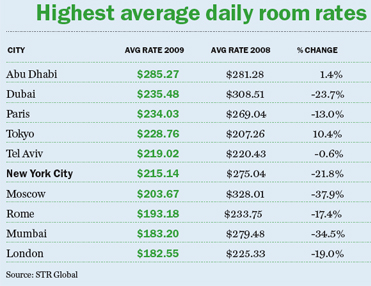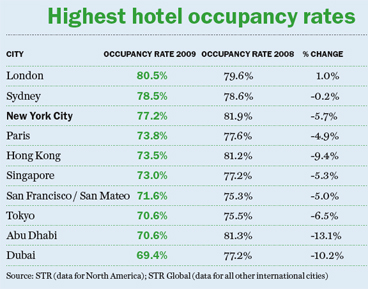New York hotels saw steep price declines last year and watched occupancy rates fall behind those of London, its main international rival. Still, the Big Apple fared better than Dubai and other high-end markets.
Hotel occupancy, one of the key statistics tracked by the hospitality industry, dropped 5.7 percent to 77.2 percent in New York last year, putting it in third place behind London, which had an 80.5 percent occupancy rate, and Sydney, which logged 78.5 percent occupancy.
That was a shift from 2008, when New York City had the highest hotel occupancy of all the cities tracked by The Real Deal, with an average of 81.9 percent of its rooms filled during the year, according to data from STR Global.
Still, other cities saw far more extreme drops: Abu Dhabi in the United Arab Emirates, for example, saw its occupancy plummet 13.1 percent, from an 81.3 percent rate to a 70.6 percent rate. Dubai’s, meanwhile, fell 10.2 percent, from 77.2 percent to 69.4 percent.
For New York, keeping up relatively high occupancy came at a price: rate declines to the tune of nearly 22 percent, and a sharp 26.3 percent drop in revenue per room, or RevPAR.
In the midst of the global recession, New York hoteliers “have offered discounts and promotional pricing to the point that they are encouraging a lot of people to take trips to New York,” said Sean Hennessey, CEO of Lodging Advisors, a Manhattan-based hotel investment advisory firm. “We’re picking up a lot of domestic visitors to New York who are taking advantage of low prices.”
By contrast, he said, “corporate travel has not rebounded very strongly.”
That’s one reason for steep price drops in New York and all over the world: Vacationers pay lower prices than corporate travelers, he said.
Despite these declines, New York still has the priciest room rates in the U.S., Hennessey said.
“Even though [New York room rates] have declined more than any other market in the past year, they still remain the highest,” he said. “The bigger they come, the harder they fall.”
London suffered less than any of the other cities The Real Deal tracked: It saw a 1 percent increase in hotel occupancy between 2008 and 2009 — the only city to see improvement during that rocky year. Jan Freitag, a vice president at STR, said one reason for the uptick was the pound’s weakness against the dollar and euro in 2009. While the average daily room rate declined by 5 percent in pounds, it declined by 15 percent in euros and 19 percent in dollars, Freitag said. (Any comparison of average daily room rates is tricky because fluctuations in exchange rates distort how expensive a hotel appears to be at any given time.)
“London was actually a cheap destination for the continent and the U.S.,” Freitag said. “In terms of ‘where can I get the most bang for my buck?’ the U.K. was a preferred destination.”
The British capital also has fewer new hotels than other markets. “It did not see the type of construction of new hotels like we had in New York City and other markets,” Hennessy noted.
Dubai, which during the boom earned a reputation as a playground for the wealthy, is suffering from an oversupply of new hotel rooms.
Between 2006 and 2007, the “‘if you build it they will come’ mentality was embraced by developers,” Freitag said.
In New York, the hotel market appears to be improving. “Occupancy has been rebounding for the past several months,” Hennessy said. “Room rates will start to turn positive again sometime within the next few months.”

